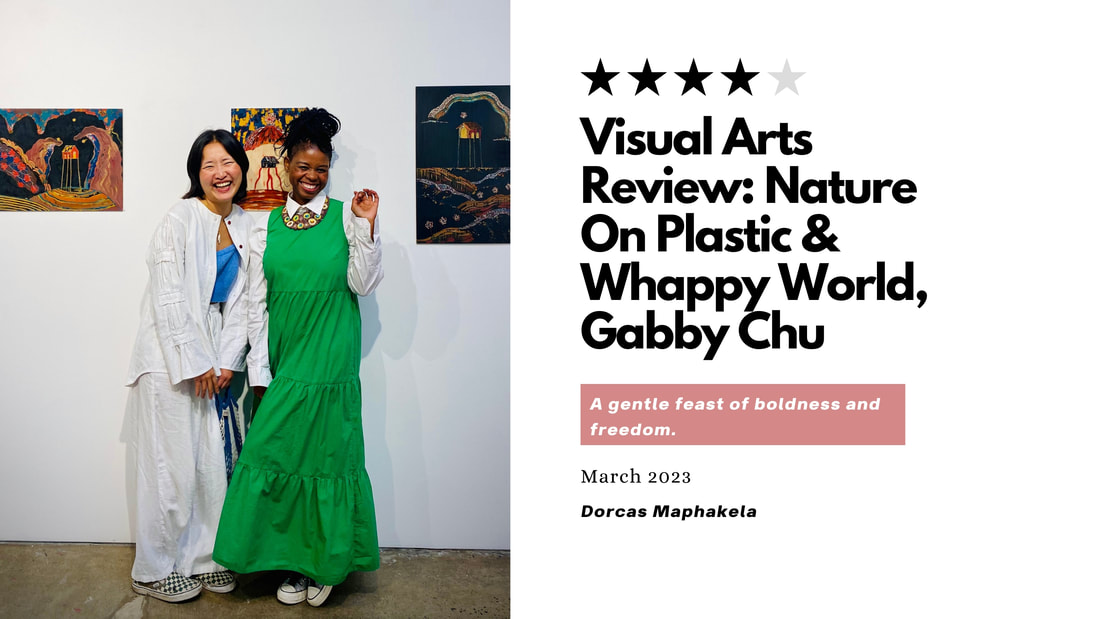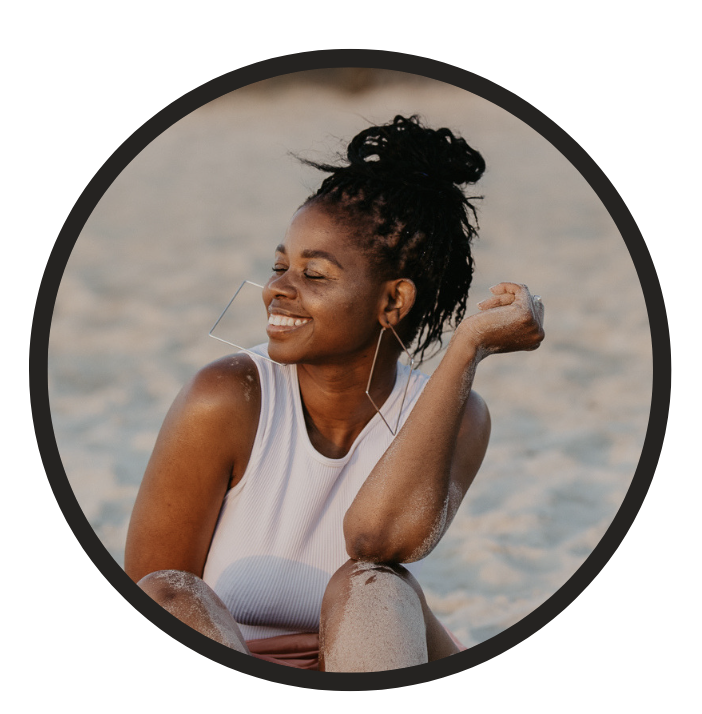Upcycle, reuse, recycle, regenerate, re … the list goes on. Here’s a question; when does art become ‘trash’ or trash become ‘art’?
A breezy Sunday afternoon in the city saw me dart along one of Melbourne’s iconic and vibrant streets rushing past some bohemian, eclectic and eccentric fashion stores, cafes and other services. It was literally the final hour for both the gallery & group exhibition on display. I braved a forty-five-minute drive all the way from the Peninsula, naturally, missing this exhibition was not an option. I raced through the gallery door of Sol on Brunswick Street in Fitzroy and it was fitting to find myself standing before an immaculately presented pile of rubbish (the artist's words).
As soon as I finished taking in the artist's statement, I was greeted by a warm unfamiliar smile. I reciprocated and quickly learned that it was Gabby Chu! We immediately connected and the rest was a blur of laughter as we walked through the exhibition in an impromptu Q&A. Can you imagine the absolute delight of being able to ask the artist directly what their work is about?
Chu’s exhibition was divided into two parts that presented differently at first glance. However, upon closer look, the works are connected by not only her medium of expression but a thread that binds human experiences. The works are aptly titled Nature On Plastic which gives a more light-hearted feel whereas Whappy World delves deeper into the artist’s lived experience.
The Medium
Nature On Plastic commands a rather slow and intimate experience for the viewer. Created with the utmost care, patience and a good measure of trusting nature; Chu juxtaposes the relationship between trash - in this case, plastic container lids and the natural process followed by her medium of choice, Ottchil.
Ott-chil literally means ‘applying Ott’ in Korean, and it refers to the traditional method of applying Ott to varnish objects (SEY) made with various materials including wood, metal, porcelain, stone or even paper. Ottchil acts as a preservative and coating and is converted to being a natural and eco-friendly lacquer attained from the sap of lacquer trees native in some Asian countries such as Korea, Japan, and China. Surfaces that are treated with this medium adorn a smooth and beautiful gloss finish which is evident in Chu’s body of work.
Learning about this technique, Chu has come to appreciate that working with Ottchil requires a labour-intensive effort. For the artist, expressing through this eco-friendly material is a process full of mystery and excitement on a daily basis. Chu says while engaged in the creative practice, “Every morning is like Christmas day, you don’t know what you’ll get because the paint is alive and can change colours throughout the process”.
The Body of Work
Hanging delicately from the ceiling was a curtain-like display comprising small square lids from takeaway containers. Each of the eight rows of plastic lids were held together by golden rings and thin wood to create what looked like a side pyramid. From afar, the structure seemed solid but as Chu playfully swung each row, it became clear that each flimsy row was holding its own; This cemented Chu’s underlying theme regarding the societal contradiction between the durability and versatility of plastic as a useful and long-lasting material as well as its damaging qualities caused through its endurance in natural environments. Blame it on poor recycling processes if you like but the reality is “one million tonnes of Australia's annual plastic consumption is single-use plastic. 84% of plastic is sent to landfill and only 13% is recycled” (Australian Government, Department of Climate Change, Energy,
the Environment and Water).
As she continued to swing the rows, Chu expressed her thoughts on the value which we place on ‘things’ and her rebellious part wished for each gallery goer who came across this work to swing it for the pure enjoyment of [its] playful nature.
A breezy Sunday afternoon in the city saw me dart along one of Melbourne’s iconic and vibrant streets rushing past some bohemian, eclectic and eccentric fashion stores, cafes and other services. It was literally the final hour for both the gallery & group exhibition on display. I braved a forty-five-minute drive all the way from the Peninsula, naturally, missing this exhibition was not an option. I raced through the gallery door of Sol on Brunswick Street in Fitzroy and it was fitting to find myself standing before an immaculately presented pile of rubbish (the artist's words).
As soon as I finished taking in the artist's statement, I was greeted by a warm unfamiliar smile. I reciprocated and quickly learned that it was Gabby Chu! We immediately connected and the rest was a blur of laughter as we walked through the exhibition in an impromptu Q&A. Can you imagine the absolute delight of being able to ask the artist directly what their work is about?
Chu’s exhibition was divided into two parts that presented differently at first glance. However, upon closer look, the works are connected by not only her medium of expression but a thread that binds human experiences. The works are aptly titled Nature On Plastic which gives a more light-hearted feel whereas Whappy World delves deeper into the artist’s lived experience.
The Medium
Nature On Plastic commands a rather slow and intimate experience for the viewer. Created with the utmost care, patience and a good measure of trusting nature; Chu juxtaposes the relationship between trash - in this case, plastic container lids and the natural process followed by her medium of choice, Ottchil.
Ott-chil literally means ‘applying Ott’ in Korean, and it refers to the traditional method of applying Ott to varnish objects (SEY) made with various materials including wood, metal, porcelain, stone or even paper. Ottchil acts as a preservative and coating and is converted to being a natural and eco-friendly lacquer attained from the sap of lacquer trees native in some Asian countries such as Korea, Japan, and China. Surfaces that are treated with this medium adorn a smooth and beautiful gloss finish which is evident in Chu’s body of work.
Learning about this technique, Chu has come to appreciate that working with Ottchil requires a labour-intensive effort. For the artist, expressing through this eco-friendly material is a process full of mystery and excitement on a daily basis. Chu says while engaged in the creative practice, “Every morning is like Christmas day, you don’t know what you’ll get because the paint is alive and can change colours throughout the process”.
The Body of Work
Hanging delicately from the ceiling was a curtain-like display comprising small square lids from takeaway containers. Each of the eight rows of plastic lids were held together by golden rings and thin wood to create what looked like a side pyramid. From afar, the structure seemed solid but as Chu playfully swung each row, it became clear that each flimsy row was holding its own; This cemented Chu’s underlying theme regarding the societal contradiction between the durability and versatility of plastic as a useful and long-lasting material as well as its damaging qualities caused through its endurance in natural environments. Blame it on poor recycling processes if you like but the reality is “one million tonnes of Australia's annual plastic consumption is single-use plastic. 84% of plastic is sent to landfill and only 13% is recycled” (Australian Government, Department of Climate Change, Energy,
the Environment and Water).
As she continued to swing the rows, Chu expressed her thoughts on the value which we place on ‘things’ and her rebellious part wished for each gallery goer who came across this work to swing it for the pure enjoyment of [its] playful nature.
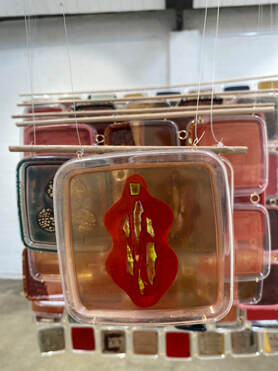
Each plastic lid has a life of its own, some are embedded with the mother of pearls, while others show off the translucent amoebic lines. The effects shine through the traditional lacquer varnish of each organically placed design that celebrates the true nature of Ottchil technique.
The artist’s palette is rich with earth tints and tones of red, ochre, brown, dark blue, yellow and green. While immersed in this work, I almost forgot that I was looking at what could possibly be trash in other circles.
The value of trash art or art created from found objects has historically been framed by the systems of consumerism surrounding the said art. As I consume this beautiful trash, I wonder if its value is based on the fact that the trash is presented against white gallery walls. or that as a viewer I attached the body of work to words like ‘eco’ or ‘sustainability’? Or perhaps because it was named ‘art’ by the owner? Whatever the view may be, these are some of the questions that come through the artist’s exploration in her juxtaposition of plastic and nature.
The artist’s palette is rich with earth tints and tones of red, ochre, brown, dark blue, yellow and green. While immersed in this work, I almost forgot that I was looking at what could possibly be trash in other circles.
The value of trash art or art created from found objects has historically been framed by the systems of consumerism surrounding the said art. As I consume this beautiful trash, I wonder if its value is based on the fact that the trash is presented against white gallery walls. or that as a viewer I attached the body of work to words like ‘eco’ or ‘sustainability’? Or perhaps because it was named ‘art’ by the owner? Whatever the view may be, these are some of the questions that come through the artist’s exploration in her juxtaposition of plastic and nature.
On the other hand, Chu’s body of work titled Whappy World, introduces the viewer to an intimate world that allows her freedom of expression. Chu says this is “the realm or dimension where my imagination is set free, it is also the safe place for my reflections”.
Chu told me that she allows herself to feel sad, vulnerable and other uncomfortable emotions that as humans, we instinctively want to hide in order to satisfy socially constructed norms.
Whappy World comprises safe houses that stand on tall legs with some presented as sculptural objects and others as 2-dimensional works. The houses represent the artist’s manner of experiencing the world where strong tall legs represent when she is feeling safe and confident or softer unstable legs at times when she feels exposed to external emotional attack(s).
Chu told me that she allows herself to feel sad, vulnerable and other uncomfortable emotions that as humans, we instinctively want to hide in order to satisfy socially constructed norms.
Whappy World comprises safe houses that stand on tall legs with some presented as sculptural objects and others as 2-dimensional works. The houses represent the artist’s manner of experiencing the world where strong tall legs represent when she is feeling safe and confident or softer unstable legs at times when she feels exposed to external emotional attack(s).
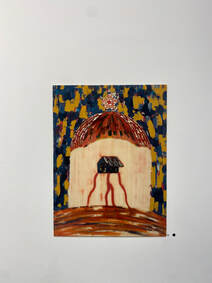
In the work titled Vulnerable, Ottchil 40 x 30cm a small safe house stands on tall unstable legs beneath a beautifully embellished umbrella. The mother-of-pearl motif exudes labour of love and care that protects the house from the uncontrollable storm that’s closing in on it.
This work is a depiction of how Chu navigates the world. No matter how wobbly she feels as she moves through the world, she also understands that it’s important to find healthy ways to protect herself against what could at times come across as an unsolicited severe lens through which the world sees her.
Chu acknowledges that there is healing power through shared lived experiences. Thus opening up her Whappy World to invite the viewer to experience “an aspect of my vulnerability, to show the viewer they are not alone in their struggles and pain”.
This work is a depiction of how Chu navigates the world. No matter how wobbly she feels as she moves through the world, she also understands that it’s important to find healthy ways to protect herself against what could at times come across as an unsolicited severe lens through which the world sees her.
Chu acknowledges that there is healing power through shared lived experiences. Thus opening up her Whappy World to invite the viewer to experience “an aspect of my vulnerability, to show the viewer they are not alone in their struggles and pain”.
Although the tone of this body of work is rather serious, Chu succeeds in finding lighter moments that keep the viewer drawn into her world.
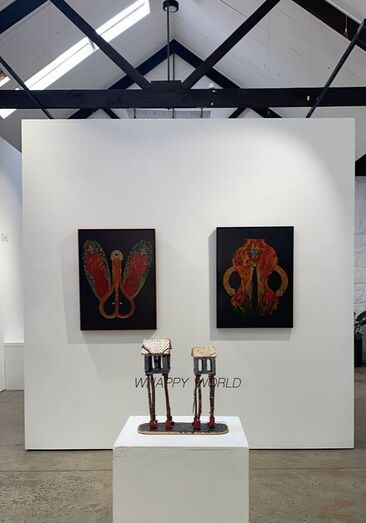
Although presented separately, the works, You and Me - ceramic, Ottchil 26 x 26.5 x 10cm, Watermelon and Papaya Vase, Ottchil, 60 x 80cm and Passion Vase, Ottchil, 60 x 80cm are intertwined in the story being told.
The latter two works were presented as wall hangings, however, within Chu’s Whappy World they can be found as objects inside the protective walls of the former work titled You and Me - ceramic, Ottchil 26 x 26.5 x 10cm which comprises two tall houses of varying sizes that proudly stand next to each other.
In line with Chu’s theme, the houses were steady and stood stately in the centre of the room, commanding the attention of the viewer. To further reiterate this confidence, Chu invites the viewer to interpret the work however they see fit through the presentation of the Vases. This is after all a creation for aesthetic pleasure which lies in the individual’s interpretation of it. Depending on the viewing lens, what she calls vases could also be seen as depictions of male and female sexual organs. In our conversation, it was clear that the artist was unshaken within her world in this particular depiction, which combined pride and whimsical creation.
Yam Prasad Sharma (2021) writes, “When we see the reflection of our nature in art … we love to see it as if we are looking for our own image in the mirror”. For both the artist and consumer, experiencing art offers a way to find a fresh perspective on one’s lived experience. Therefore by inviting the viewer into her emotional process and healing, Chu lays a retreat into the abstract ideas and imagination that lives within all of us.
The latter two works were presented as wall hangings, however, within Chu’s Whappy World they can be found as objects inside the protective walls of the former work titled You and Me - ceramic, Ottchil 26 x 26.5 x 10cm which comprises two tall houses of varying sizes that proudly stand next to each other.
In line with Chu’s theme, the houses were steady and stood stately in the centre of the room, commanding the attention of the viewer. To further reiterate this confidence, Chu invites the viewer to interpret the work however they see fit through the presentation of the Vases. This is after all a creation for aesthetic pleasure which lies in the individual’s interpretation of it. Depending on the viewing lens, what she calls vases could also be seen as depictions of male and female sexual organs. In our conversation, it was clear that the artist was unshaken within her world in this particular depiction, which combined pride and whimsical creation.
Yam Prasad Sharma (2021) writes, “When we see the reflection of our nature in art … we love to see it as if we are looking for our own image in the mirror”. For both the artist and consumer, experiencing art offers a way to find a fresh perspective on one’s lived experience. Therefore by inviting the viewer into her emotional process and healing, Chu lays a retreat into the abstract ideas and imagination that lives within all of us.
This exhibition was cleverly presented and succeeded in expressing complex human experiences in a gentle and enjoyable manner that safely invited the viewer to explore quiet moments of retrospection.
|
Dorcas Maphakela is a writer, visual artist and holistic well-being advocate, using art and words to share knowledge and inspiration on living a full life. She is also a TV presenter, public speaker and founder and producer of the Antenna Award-winning OZ AFRICAN TV (OATV). Alongside her role with Multicultural Arts Victoria, Dorcas co-founded Yo CiTY, a platform that champions the culturally diverse experience through Art & music. Dorcas is an Academic Screen Lecturer at the University of Melbourne. She studied Fine Arts and Master of Arts in Writing.
Her work was acknowledged with a Media Award from the Victorian Multicultural Commission for “outstanding reporting on issues of importance to diverse communities and reporting which contributes to Victoria’s cross-cultural understanding” (VMC). |
